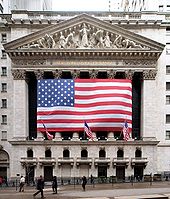 The United States has a capitalist mixed economy, which is fueled by abundant natural resources, a well-developed infrastructure, and high productivity. According to the International Monetary Fund, the U.S. GDP of $14.4 trillion constitutes 24% of the gross world product at market exchange rates and almost 21% of the gross world product at purchasing power parity (PPP). It has the largest national GDP in the world, though it is about 5% less than the GDP of the European Union at PPP in 2008. The country ranks seventeenth in the world in nominal GDP per capita and sixth in GDP per capita at PPP.
The United States has a capitalist mixed economy, which is fueled by abundant natural resources, a well-developed infrastructure, and high productivity. According to the International Monetary Fund, the U.S. GDP of $14.4 trillion constitutes 24% of the gross world product at market exchange rates and almost 21% of the gross world product at purchasing power parity (PPP). It has the largest national GDP in the world, though it is about 5% less than the GDP of the European Union at PPP in 2008. The country ranks seventeenth in the world in nominal GDP per capita and sixth in GDP per capita at PPP.The United States is the largest importer of goods and third largest exporter, though exports per capita are relatively low. In 2008, the total U.S. trade deficit was $696 billion. Canada, China, Mexico, Japan, and Germany are its top trading partners. In 2007, vehicles constituted both the leading import and leading export commodity. Japan is the largest foreign holder of U.S. public debt, having surpassed China in early 2010. The United States ranks second in the Global Competitiveness Report.
In 2009, the private sector is estimated to constitute 55.3% of the economy, with federal government activity accounting for 24.1% and state and local government activity (including federal transfers) the remaining 20.6%. The economy is postindustrial, with the service sector contributing 67.8% of GDP, though the United States remains an industrial power. The leading business field by gross business receipts is wholesale and retail trade; by net income it is manufacturing. Chemical products are the leading manufacturing field. The United States is the third largest producer of oil in the world, as well as its largest importer. It is the world's number one producer of electrical and nuclear energy, as well as liquid natural gas, sulfur, phosphates, and salt. While agriculture accounts for just under 1% of GDP, the United States is the world's top producer of corn and soybeans. The New York Stock Exchange is the world's largest by dollar volume.Coca-Cola and McDonald's are the two most recognized brands in the world.
In the third quarter of 2009, the American labor force comprised 154.4 million people. Of those employed, 81% had jobs in the service sector. With 22.4 million people, government is the leading field of employment.About 12% of workers are unionized, compared to 30% in Western Europe. The World Bank ranks the United States first in the ease of hiring and firing workers. Between 1973 and 2003, a year's work for the average American grew by 199 hours. Partly as a result, the United States maintains the highest labor productivity in the world. In 2008, it also led the world in productivity per hour, overtaking Norway, France, Belgium and Luxembourg, which had surpassed the United States for most of the preceding decade. Compared to Europe, U.S. property and corporate income tax rates are generally higher, while labor and, particularly, consumption tax rates are lower.